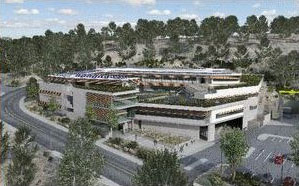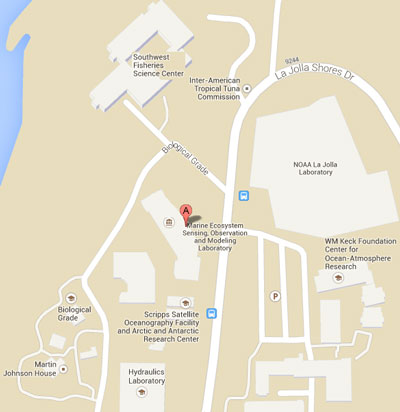 Marine Ecosystem Sensing, Observation and Modeling (MESOM) Laboratory at Scripps Institution of Oceanography, University of California San Diego. 8880 Biological Grade, La Jolla, California
Marine Ecosystem Sensing, Observation and Modeling (MESOM) Laboratory at Scripps Institution of Oceanography, University of California San Diego. 8880 Biological Grade, La Jolla, California
The Marine Ecosystem Sensing, Observation and Modeling (MESOM) Laboratory at Scripps Institution of Oceanography opened in August 2013. This three-story, 21,300 square feet building has 12 laboratories, 56 offices and three conference rooms.
The facility is home to a new multidisciplinary program at Scripps aimed at:
- conducting long-term observation of the ocean ecology of the California Current Ecosystem (CCE), and then forecast changes to the CCE based on coupled physical and biological/ecological numerical models.
- Integrating the development of physical, biological and chemical sensors and the autonomous ocean-going platforms to support them.
Located in the SIO Coastal Observations Neighborhood and across the street from the new NOAA Southwest Fisheries building, home of CalCOFI's Fisheries program, the MESOM laboratory provides an environment for coastal ecosystem biologists & oceanographers to work collaboratively on an integrated approach to understanding California’s coastal waters. Results of the research conducted in this building & the new Southwest Fisheries Science Center are expected to provide the foundation for new approaches to management of the State of California’s marine ecosystems and their resources. CalCOFI research not only provides physical & biological measurements of the California Current Ecosystem, but produces useful information for resource managers, decision makers and the public to guide them through today’s environmental challenges.
 The new Southwest Fisheries Science Center laboratory is directly across La Jolla Shores Drive from MESOM & its predecessor at the northern end of the campus of Scripps institution of Oceanography, U.C. San Diego (UCSD). The facility contains an experimental aquarium, a large animal necropsy lab, a specimen processing lab, a photogrammetry lab, an ichthyoplankton lab, genetic labs, physiology labs, oceanographic labs, specimen archives, electronic workshops and a large tank for testing new sampling technologies, plus a library, conference rooms and office space for 275 scientists and support staff. The new facility allows the SWFSC to continue its legacy surveys and monitoring programs while incorporating new technologies in the provision of advice on the conservation and management of living marine resources in the California Current, Eastern Tropical Pacific and Antarctic ecosystems. The design of the new laboratory calls for photovoltaic cells, elaborate water retention systems, recycled materials and green roofs planted with California coastal chaparral, and is expected to earn a LEED Gold Level Certification.
The new Southwest Fisheries Science Center laboratory is directly across La Jolla Shores Drive from MESOM & its predecessor at the northern end of the campus of Scripps institution of Oceanography, U.C. San Diego (UCSD). The facility contains an experimental aquarium, a large animal necropsy lab, a specimen processing lab, a photogrammetry lab, an ichthyoplankton lab, genetic labs, physiology labs, oceanographic labs, specimen archives, electronic workshops and a large tank for testing new sampling technologies, plus a library, conference rooms and office space for 275 scientists and support staff. The new facility allows the SWFSC to continue its legacy surveys and monitoring programs while incorporating new technologies in the provision of advice on the conservation and management of living marine resources in the California Current, Eastern Tropical Pacific and Antarctic ecosystems. The design of the new laboratory calls for photovoltaic cells, elaborate water retention systems, recycled materials and green roofs planted with California coastal chaparral, and is expected to earn a LEED Gold Level Certification.
